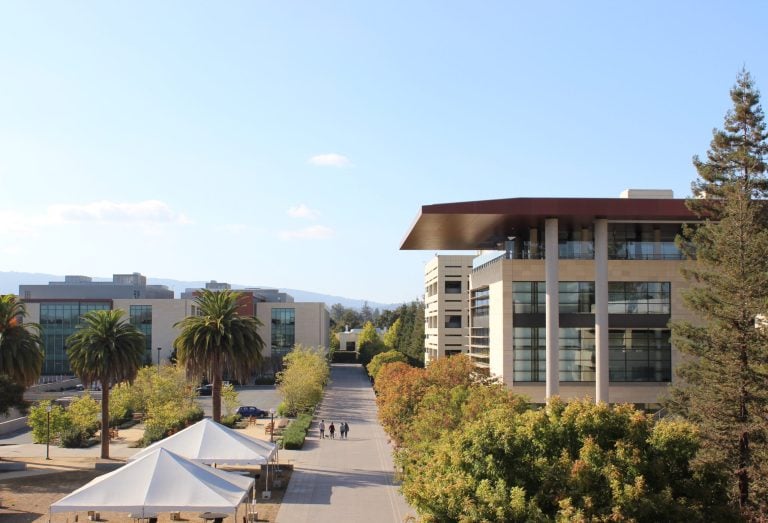Seven-month-old Soren Good became the youngest participant in Stanford Medicine’s Pfizer vaccine trial on April 21. He and his three-year-old brother Andel are two of nearly 150 children under five years old who will be vaccinated during the first phase of Pfizer’s pediatric dose-finding study in the United States.
“Initially, the thinking was that kids don’t get very sick when they contract COVID, but now we understand that even though kids [have a low mortality rate], several kids do die every month in the United States from this virus,” the boys’ mother, Zina Good Ph.D. ’18, said.
Stanford’s branch of the nationwide trial is led by physicians Yvonne Maldonado, professor of pediatric infectious diseases, and Jenna Bollyky, clinical assistant professor of pediatrics and infectious diseases.
A Stanford researcher who is studying immunology herself, Good said that while her work is not directly related to COVID-19, her background knowledge of the immune system gave her the confidence to enroll her children in the trial.
“I think there’s quite a lot of variation with how comfortable families are in vaccinating their children,” she said. “It has never been done in kids this age before, so I can understand how it would be a bit scary for many parents.”
Bollyky said the study is focused both on finding the correct vaccine dosage and safety. “It’s really important that we work to find a safe and effective dose for children so that we can get our entire country closer to herd immunity,” she said.
Children aged five to 12 years first received a 10 microgram dose in groups of 48 participants across the country. Once that was deemed safe, the dosage escalated to 20 micrograms and then 30 micrograms. All participants in the trial have been guaranteed a vaccine: None will receive a placebo. The trial is also open-label, which means parents and researchers know the dose that each child receives.
For children under five, the dose was even smaller. Soren and Andel received a three microgram dose. They will return to the clinic three weeks after their first shot to receive their second dose. A week after that, they will receive a blood test to measure antibody levels and see if the children achieved adequate protection against COVID-19.
Bollyky explained that finding the correct dose requires a fine balance between safety and efficacy: “If we give too little, the body might not have enough to mount the immune response, but if we give too much the immune system may be overwhelmed, creating unwanted side effects.”
She and Maldonado also say that vaccinating children is crucial to stopping the spread of the disease.
“[Children are] about a quarter, or a little under a quarter, of our U.S. population,” Maldonado said in a statement to ABC7 News. “So it’s really important if we want to get herd immunity to include children.”
Good explained that, like in adults, COVID-19 can have long-term health consequences for children, even if they are initially only mildly symptomatic. These long-term effects, called “long-COVID” by scientists, occur in 13-15% of children who are infected with the virus. A study conducted on children in Italy who had been infected with COVID-19 found that nearly half of the children experienced symptoms that lasted more than 120 days. Long-COVID symptoms in children include prolonged lethargy, chest pain, gastrointestinal problems and headaches. Almost half of children surveyed in a recent study said that these symptoms interfered with their daily lives.
“Because of lung damage due to long-COVID, some kids cannot run as fast or participate in sports as much as they used to,” said Good. “Some kids are severely affected and have a hard time going up the stairs or even getting out of bed.” She’s hoping the vaccine will help to protect her children from the disease, especially as schools and daycares start to reopen.
“With any medical treatment, you want to make sure that the risks are outweighed by the benefits,” Bollyky said. “There’s an incredible benefit that we’ve seen so far in these vaccines’ ability to prevent severe COVID disease in adults, and we hope that this will be true in children as well.”
The researchers hope that parents who are hesitant now might feel more comfortable enrolling in the second phase of the trial, for which enrollment will begin on May 17. By then, they will have determined a dose for each age group, and the second phase will include a placebo group, focusing more on efficacy and understanding side effects.
Bollyky also hopes that the second phase of the trial will better represent the racial and ethnic diversity of the Bay Area, as many racial and ethnic groups have historically faced barriers to enrolling in these trials. She explained that it is important for researchers to “be more proactive in including these patients,” adding that the team has partnerships with local clinics all around the Bay Area and “will work with them to enroll a population that [accurately reflects] our community.”
Good encouraged other parents to participate in the trial, adding that it is important to talk with kids about the pandemic as a whole so they can learn about the important role they can play in protecting their community.
“My three-year-old understands that there is a virus that can make people very sick, and he understands why it’s important to wear a mask and social distance at school,” she said. “He really likes airplanes, and he understands that if he wants to travel in the future it’s really important for him to be vaccinated.”
